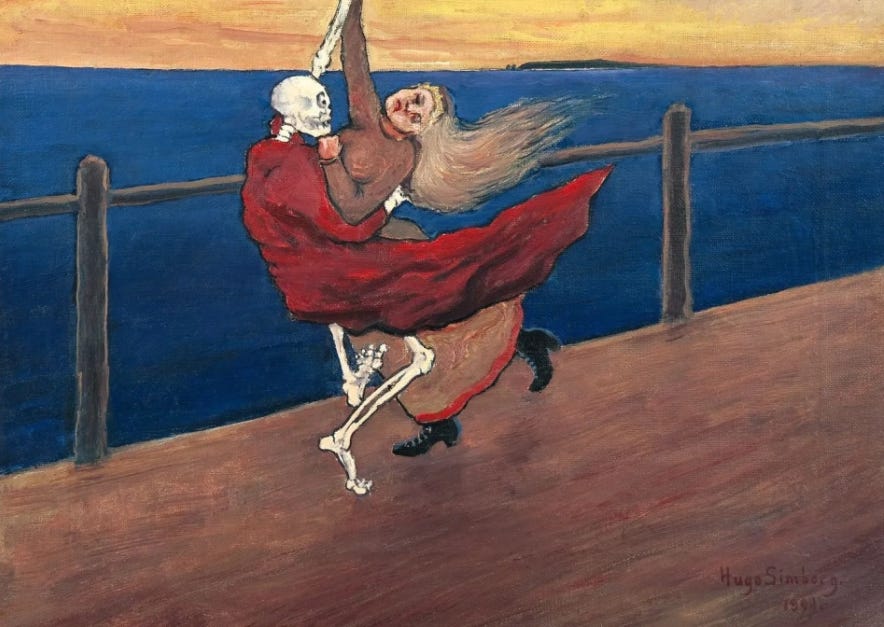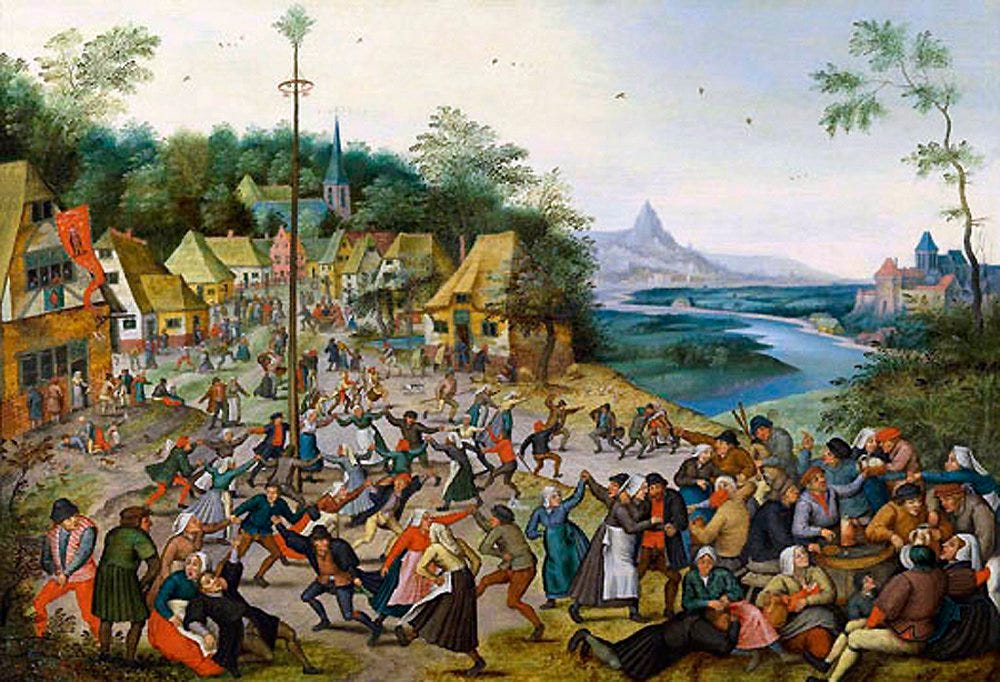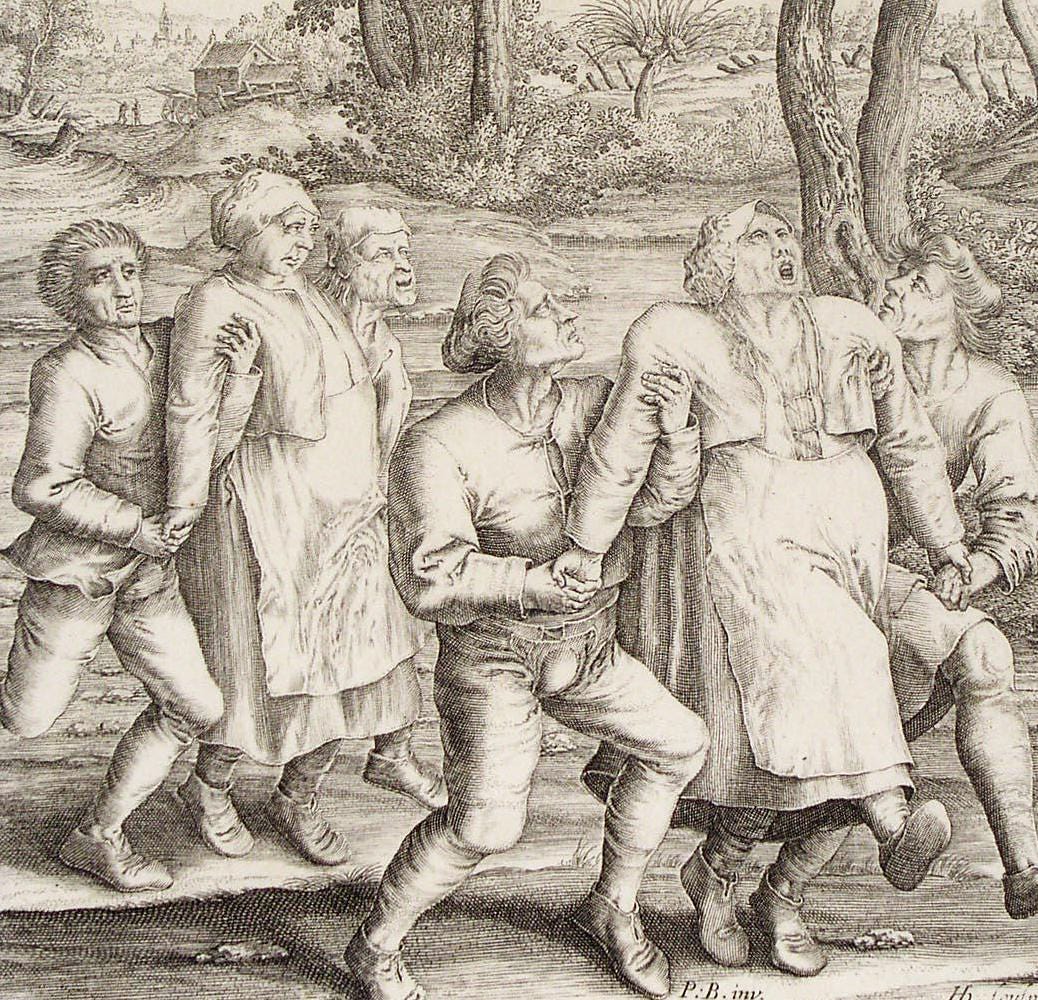The Dancing Plague of 1518
The Mystery Behind Strasbourg's "Choreomania" with Historical Testimonies, Centuries-Old Theories, and Supernatural Forces at Play
Let’s set the scene: Strasbourg, Alsace — now modern-day France — July 1518. At this time, Strasbourg was part of the Holy Roman Empire and a bustling, thriving city located on the Rhine River.
The city was a significant center for trade and commerce, with a population of around 20,000 people. Its streets were narrow and winding, flanked by half-timbered houses with steeply pitched roofs.
On any given day, the city would be filled with merchants selling their wares, craftsmen working in their shops, and townsfolk going about their daily business.
But on July 14th, 1518, something extraordinary started to unfold. In a narrow-cobbled street outside her home, a woman named Frau Troffea began to dance.
Not the kind of dancing you might imagine—no music, no rhythm, no joy. Instead, she moved frantically, her body possessed by an unseen force. Her deeply concerned husband tried to intervene, begging her to stop.
But she wouldn’t…. or couldn’t. She danced on, her feet pounding the pavement without pause, for hours, then days.
Frau Troffea’s Dance with the Devil
By the second and third days, crowds began to gather. Neighbors, porters, beggars, even nuns and priests—everyone came to witness this bizarre spectacle.
Was she bewitched? Cursed? Or simply mad? These were the questions we can imagine were on everyone’s lips as they watched Frau Troffea dance without rest, neither eating nor drinking.
By the fourth day, the city council decided to intervene, fearing that this unnatural display might be a sign of something more sinister. They ordered Frau Troffea to be taken to the shrine of St. Vitus, located some thirty miles away near Zabern, now known as Saverne.
St. Vitus was the patron saint of epileptics and dancers, and it was believed that his intercession might cure her of this madness. But as Frau Troffea was whisked away, something remarkable—and terrifying—happened.
Others joined in the dance.
The Spectacle of Sin: Strasbourg’s Stricken Streets
Within days, what had started as an isolated incident grew into a full-blown epidemic. Men, women, and children alike were struck by the same compulsive urge to dance.
At first, it was just a handful, but at the end of the two-month long ordeal, nearly 400 people were gripped by the same uncontrollable impulse. They danced in the streets, in the markets, in the churchyards. They danced until their feet were bloody, until they collapsed from exhaustion.
Some of them danced themselves to death.
Perfect Conditions for a Nightmare
This wasn’t the first time such an event had occurred in Europe. Similar outbreaks of dancing mania had been reported throughout the Middle Ages, along the Rhine and Moselle rivers since 1374, though none were as well-documented as the one in Strasbourg.
The phenomenon was known as “choreomania” or St. Vitus’ Dance, named after the same saint to whom Frau Troffea and others were taken.
The scene was nightmarish. Bodies convulsed in rhythmic motion, day and night, unable to stop.
The city authorities, desperate to contain the madness, tried to turn the frenzy into something orderly. They sought advice from the guild of physicians, who followed an early Western physiological theory of medicine called humoralism, where it was believed four bodily fluids were thought to determine a person’s temperament and features.
The guild discerned the dance to be a “natural disease, which comes from overheated blood.”
They constructed a stage, hired musicians, and even brought in professional dancers to guide the movements of the afflicted.
It was believed that perhaps if the dancers were given an outlet, they could exhaust the fever burning within them.
But the human body has its limits. Over the course of two months, the toll was devastating. Many of the dancers collapsed from sheer exhaustion; others suffered heart attacks or strokes, and some even danced themselves to death.
By September, the authorities, in a final desperate attempt to save the remaining dancers, transported them to the mountaintop shrine of St. Vitus, praying for divine intervention. Only then did the plague begin to wane.
What could have caused such a bizarre phenomenon? To understand this, we need to consider the broader context in which the Dancing Plague occurred.
The early 16th century was a time of great upheaval in Europe. The continent was ravaged by wars, famine, and disease. The Bubonic Plague, or Black Death, had swept through Europe in the 14th century, killing an estimated 25 million people, nearly a third of the population.
Though the worst of the plague had passed by the early 1500s, its impact was still deeply felt. The fear of disease was pervasive, and the memory of the Black Death lingered like a shadow over the land.
In addition to the threat of disease, the people of Strasbourg were also grappling with the effects of severe economic hardship. The region had been hit by a series of poor harvests, leading to widespread famine.
The summers were unusually dry, and the winters were particularly harsh, resulting in crop failures and food shortages. The price of grain soared, and many people found themselves on the brink of starvation. The social fabric of the city was fraying.
Religious tension was also a significant factor. The early 16th century was a time of great religious upheaval in Europe, as the Protestant Reformation was beginning to take hold.
Martin Luther’s Ninety-Five Theses had been nailed to the church door in Wittenberg just a year earlier, in 1517, sparking a movement that would eventually lead to the splintering of the Catholic Church.
Strasbourg, a city with a strong religious tradition, was not immune to these changes. There was a growing divide between those who remained loyal to the Catholic Church and those who were beginning to embrace Lutheranism. This religious discord added another layer of stress to an already tense situation.
Centuries Worth of Theories
Given these conditions, it’s not surprising that the people of Strasbourg were in a state of heightened anxiety. But how did this anxiety translate into a mass outbreak of uncontrollable dancing?
Historical accounts offer different perspectives on the cause of the phenomenon. One 17th-century chronicle by the Strasbourg jurist Johann Schilter quotes a now-lost manuscript poem, describing the dancers as follows:
"Many hundreds in Strasbourg began
To dance and hop, women and men,
In the public market, in alleys and streets,
Day and night; and many of them ate nothing
Until at last the sickness left them.
This affliction was called St. Vitus’ dance."
Another chronicle from 1636 provides a more somber account:
"In the year 1518 AD . . . there occurred among men a remarkable and terrible disease called St. Vitus’ dance, in which men in their madness began to dance day and night until finally they fell down unconscious and succumbed to death."
These accounts paint a vivid picture of the sheer madness that gripped Strasbourg in the summer of 1518. But they also hint at the deep-seated fear and superstition that underpinned the response to the plague.
The people of Strasbourg were living in a world where the line between the natural and supernatural was thin. To them, the idea that a saint could curse someone with a dancing plague was not only plausible—it was reality.
Modern-day historians and scientists have grappled with this question for centuries, and several more likely theories have been proposed.
One theory, though less widely accepted and evidentially disputed, is that the dancers were suffering from ergotism, a condition caused by the ingestion of ergot, a toxic mold that grows on damp rye.
Ergot contains alkaloids that can cause severe convulsions, hallucinations, and other symptoms that might explain the frantic dancing. However, ergotism typically causes more convulsive, less rhythmic movements, which doesn’t fully align with the reports of the dancing plague.
But the most widely accepted explanation is that the Dancing Plague was a case of mass hysteria, or what modern psychologists call “collective psychogenic illness.” This condition occurs when a group of people, often in the face of extreme stress or social upheaval, experiences the same physical symptoms without a clear physical cause.
In the case of Strasbourg, the stress and hardships of the time, combined with a deeply ingrained belief in the supernatural, may have triggered a collective outbreak of dancing mania.
The Power of the Mind Yesterday and Today
It’s worth noting that mass psychogenic illness is not a relic of the past, nor an isolated incident in a town in France. Throughout history, and even into the modern era, we've seen similar outbreaks of collective hysteria, each shaped by the unique pressures and fears of the time.
Take, for example, the "Sleeping Beauty Syndrome" in Kalachi, Kazakhstan. Between 2013 and 2014, dozens of residents in this small village suddenly began falling into deep, unexplained sleep that could last for days.
The cause? Some speculated radiation or toxic gasses, but many experts believe it was a case of MPI, or mass psychogenic illness, likely triggered by anxiety related to the village’s proximity to an abandoned uranium mine.
Then there's the case of Le Roy, New York, in 2011, where a group of teenage girls at a high school started displaying symptoms similar to Tourette Syndrome—exhibiting uncontrollable tics and verbal outbursts.
The symptoms spread rapidly among the students, causing widespread concern. After extensive medical testing, no physical cause was found, and experts concluded that it was another instance of MPI, likely exacerbated by stress and social factors.
And perhaps the most infamous example of all: the Salem Witch Trials of 1692. A group of young girls in Salem Village began exhibiting strange behaviors—fits, convulsions, and outbursts—which were quickly attributed to witchcraft.
The ensuing panic led to the execution of 20 people and the imprisonment of many more. While the trials are often remembered as a tragic case of religious fanaticism, they also represent a classic example of mass hysteria, fueled by fear, superstition, and social tensions.
Is it All in Our Heads?
The response to the Dancing Plague was, in many ways, a reflection of the times. The city authorities, desperate to contain the crisis, resorted to measures that seem bizarre to us today.
They built a stage, hired musicians, and even brought in professional dancers to help the afflicted “dance it out.” The idea was that if the dancers could simply exhaust themselves, the plague would subside. But instead of alleviating the problem, these efforts only seemed to fuel the fire.
By August, the situation had reached a breaking point. The relentless dancing had taken its toll on the participants, many of whom had collapsed from exhaustion, suffered heart attacks, or died from strokes.
The city council, realizing that their initial approach had failed, decided to try a different tactic. They ordered the remaining dancers to be taken to the shrine of St. Vitus on a mountaintop near Zabern. There, they were to pray for absolution, in the hopes that the curse would be lifted.
And, as if by a miracle, the dancing finally stopped.
I Could Have Danced All Night: A Conclusion
The Dancing Plague of 1518 remains one of the most bizarre episodes in history. It serves as a reminder of the influence of the mind and the deep-seated beliefs that can drive human behavior to extreme and sometimes deadly ends.
In a world where the boundaries between the natural and supernatural were blurred, the people of Strasbourg turned to the explanations they knew—curses, saints, and divine retribution.
But what truly underpinned this bizarre outbreak was not just the fear of a vengeful saint, but the overwhelming power of collective belief and the human mind’s capacity to manifest physical symptoms in the face of extreme stress.
Whether through religious fervor, social pressures, or the dire circumstances of the time, the people of Strasbourg danced not because they chose to, but because their minds and bodies compelled them to in a desperate attempt to make sense of a world that seemed to be falling apart.
The mind can heal, create, and inspire, but it can also destroy, distort, and lead us down strange and perilous paths. The events of 1518 are a testament to this power—a story where saints and sinners, fear and faith, all danced together in a tragic, mesmerizing waltz.
Credits
Research, writing, and hosting by Kate Naglieri
Production and sound by Jamie Eichhorn
Sources
Dancing plague of 1518 | Facts & Theories | Britannica
https://www.imt.ie/features-opinion/uncommon-diagnosis-the-dancing-plague-of-1518-09-03-2022/
https://publicdomainreview.org/essay/the-dancing-plague-of-1518/
Religious dances: in the Christian church and in popular medicine by Backman, E. Louis (Eugène Louis), 1883-1965, author
The Dance of Death paintings in the 14 and 1500s: A Brief History of the 'Danse Macabre' - Atlas Obscura







